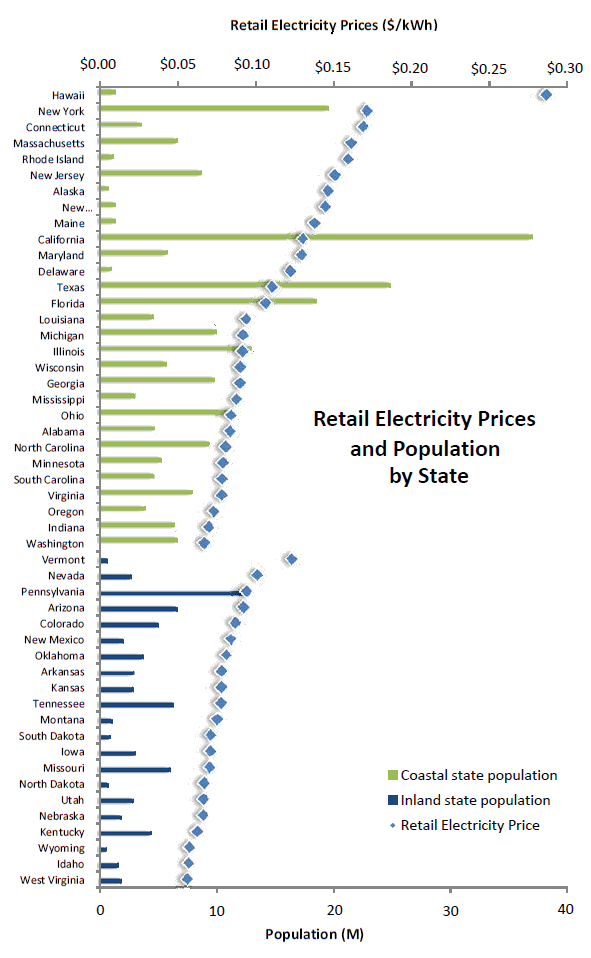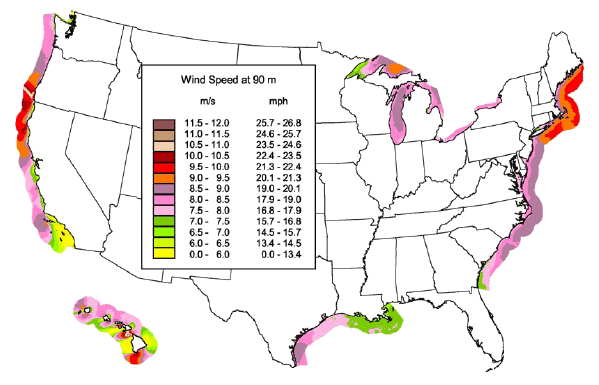US Offshore Wind Strategy
February 15, 2011
In a
previous article (Atlantic Wind Power, November 11, 2010), I summarized the plans of a consortium of companies called the
Atlantic Wind Connection to construct an
undersea transmission cable about twenty miles off the
Atlantic seaboard of the US. This 350 mile, six
gigawatt capacity transmission system, optimistically to be completed by 2021, would provide electrical connection to offshore
wind farms. This other piece of the renewable energy puzzle, the offshore wind farms that would feed this transmission line, has gotten a recent boost from the US government.
On February 7, 2011, the
US Department of the Interior and the
US Department of Energy unveiled a coordinated strategic plan to accelerate the development of offshore wind energy.[1-7] This is part of a national plan for the US to generate 80% of its electricity from
clean energy sources by 2035, and it includes a small ($50.5 million over five years) allotment for
research and development projects that support offshore wind energy deployment. The funding will be split as follows:[6]
• $25 million over five years for the design and development of turbines and turbine control systems.
• $18 million over three to study market barriers for wind power and ways to surmount them.
• $7.5 million over three years to design drivetrains for future wind turbines.
Steven Chu,
Secretary of Energy, had the following to say about the plan:
"Offshore wind energy can reduce greenhouse gas emissions, diversify our energy supply, and stimulate economic revitalization... The Department of Energy is committed to working with our federal partners to provide national leadership in accelerating offshore wind energy deployment."[7]
The US Department of Energy wants enough offshore wind farm capacity to generate 54 gigawatts of electricity by 2030; so, the five gigawatt Atlantic Wind Connection would be just a small piece in a very large strategy that would cover the entire US seaboard. There's an interim 2020 target of 10 gigawatts, and a cost target of ten cents per
kilowatt-hour in 2020, and seven cents per kilowatt-hour in 2030.[3] It's not specified whether this pricing is in present day dollars, or
future dollars. This is quite a bit less than my current
New Jersey electrical cost, as shown in the figure.

Electrical prices and population, from page 7 of "A National Offshore Wind Strategy." (reformatted, from Ref. 4).
There's no question that the US lags far behind other countries in offshore wind deployment. One of the key points in the strategy document is that there are no wind turbines presently installed in U.S. waters. For this reason, there's a dearth of data on the environmental and siting effects of turbines; and also on the installation, operation, and maintenance of such turbines. Such
uncertainty drives up the
capital cost of the first few installations. The US has shoreline and winds aplenty, as the following figure shows.

US offshore wind speeds, from page 6 of "A National Offshore Wind Strategy."[4]
The portion of the strategy document most interesting to technologists is the section on technology development, which lists and summarizes the following
activity areas:
1.1: Computational Tools and Test Data
1.1.1: Performance Modeling and Validation
1.1.2: Design Tools and Standards
1.1.3: Field Testing
1.2: Innovative Turbines
1.2.1: New Turbine Concepts
1.2.2: Advanced Drive Concepts
1.2.3: Controls and Power Electronics
1.3: Marine Systems Engineering
1.3.1: Support Structures
1.3.2: Balance of System
The first areas targeted for offshore wind energy are
Delaware (122 square
nautical miles),
Maryland (207),
New Jersey (417), and
Virginia (165). The US Department of the Interior will then research areas off of
Massachusetts,
Rhode Island and
North Carolina.[2]
Although many people object to offshore wind for
aesthetic reasons, there are some not-so-obvious problems that need to be addressed. One of these is the potential for
electromagnetic interference with
radar,
Automatic Identification Systems (AIS),
Global Positioning Systems (GPS), shipboard radios,
SONAR and
Coastal Ocean Dynamics Applications Radar (CODAR).[4]
References:
- Department of Energy and Department of the Interior Announce Major Offshore Wind Strategy, Energy Efficiency and Renewable Energy Web Site, Department of Energy, February 7, 2011.
- Kendra Barkoff, "Salazar, Chu Announce Major Offshore Wind Initiatives," Department of Energy Press Release, February 7, 2011.
- Overview: National Offshore Wind Strategy, Department of the Interior Web Site.
- Jacques Beaudry‐Losique (U.S. Department of Energy), Ted Boling (U.S. Department of Interior), et al., "A National Offshore Wind Strategy-Creating an Offshore Wind Energy Industry in the United States," U.S. Department of Energy, Office of Energy Efficiency and Renewable Energy, Wind & Water Power Program and U.S. Department of the Interior, Bureau of Ocean Energy Management, Regulation, and Enforcement, February 7, 2011.
- Pete Danko, "A Gust of Support for U.S. Offshore Wind Energy," EarthTechling via Reuters, February 8, 2011.
- Pete Danko, "U.S. Offshore Wind Gets More Organized,"EarthTechling, February 8, 2011.
- John Platt, "Offshore wind power: Feds announce $50.5 million in funding," Forbes Blogs, February 9, 2011.
- Map of Areas under Consideration for Wind Energy Areas, US Department of Energy.
- Bureau of Ocean Energy Management, Regulation and Enforcement's Renewable Energy Webpage.
- Department of Energy's Wind & Water Power Program Webpage.
Permanent Link to this article
Linked Keywords: Atlantic Wind Connection; undersea transmission cable; East Coast of the United States; Atlantic seaboard; gigawatt; wind farm; US Department of the Interior; US Department of Energy; clean energy sources; research and development; wind turbine; control system; market barrier; drivetrain; Steven Chu; Secretary of Energy; kilowatt-hour; time value of money; future dollars; New Jersey; Electrical prices and population; A National Offshore Wind Strategy; risk management; uncertainty; capital cost; US offshore wind speeds; Delaware; nautical mile; Maryland; New Jersey; Virginia; Massachusetts; Rhode Island; North Carolina; aesthetic; electromagnetic interference; radar; Automatic Identification System; AIS; Global Positioning System; GPS; SONAR; Coastal Ocean Dynamics Applications Radar; CODAR.